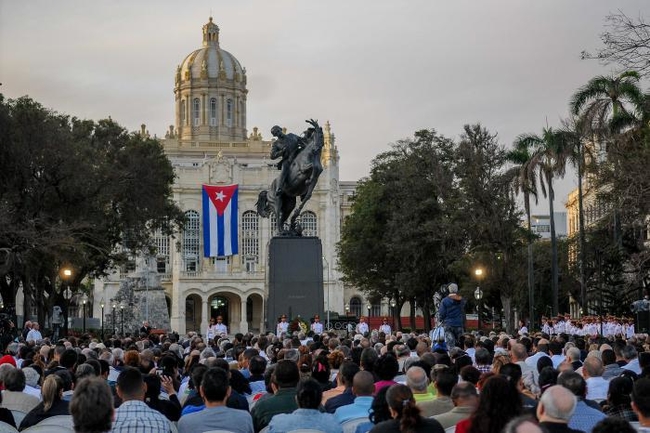Equestrian statue of José Martí officially unveiled
Granma | Tuesday, 30 January 2018 | Click here for original article

To commemorate the 165th anniversary of the birth of José Martí, Cuba’s national hero, officially unveiled in Havana’s 13 de Marzo Park was a replica of the equestrian statue sculpted by Anna Hyatt Huntington, that since 1965 honours him in New York City. Army General Raúl Castro Ruz, first secretary of the Communist Party of Cuba Central Committee and President of the Councils of State and Ministers, presided the event, January 28, with the participation of members of the Party Political Bureau and the Council of State, government authorities, representatives from the New York mayor’s office, the Bronx Museum, and U.S. citizens who contributed to the project’s realization.
José Martí saw in necessary death the uplifting and triumph of life, and spoke of the need to die for good, in order to continue living. This was perhaps the aura of the tribute in which Cuba’s most universal citizen was evoked by those who spoke of him as having become immortal given his extraordinary dimensions.
Speaking in the name of the Bronx Museum of Art, the prestigious institution that guided the project, and its recently deceased director Holly Block, was the institution’s administrative board chairman Joseph Mizzi, who said it was an honour to attend the ceremony to present the statue to the Cuban people.
Mizzi emphasised Ms. Block’s determination, even as her health deteriorated, to complete the project that symbolised the enduring friendship shared by the peoples of the United States and Cuba. To make it a reality, she worked tirelessly, he said, noting that everyone involved in the process learned a great deal about Martí’s work - and shared it with others – including his commitment to Cuban independence, the importance of human dignity, and even the history of the United States, about which Martí wrote during the 15 years he lived in the country. Mizzi thanked the more than 100 donors who made the project possible, and especially Leanne Mella, also in attendance.
A message from New York City Mayor Bill de Blasio was read by his representative, José A. Velázquez Zaldívar, in which he referred to the majestic statue in his city’s Central Park as a source of inspiration and empowerment for New York Cubans, and expressed his conviction that the replica in Havana will ensure that Martí’s historic legacy - in search of Cuba’s independence - will be shared by future generations. In conclusion, Velázquez said he was proud to be present on the occasion of the commemoration, to celebrate the friendship that his city honourably shares with Cuba.
Dr. Eusebio Leal Spengler, Havana City Historian, made the event’s central remarks, adding lyricism and fervour to the ceremony, saying, “Everything calls us to recollection this morning and to devout gratitude to the country’s founding fathers,” he said, recalling that Martí’s birth, 165 years ago, took place not far from the park, on Paula Street.
He continued, in his sure, deliberate manner, noting the aesthetic brilliance of the statue that marked the artist’s life.
He explained that, at 82 years of age, the sculptor took on the project thinking that in New York, alongside the statues of Simón Bolívar and José de San Martín in Central Park, missing was a fundamental piece – that she would eventually provide – to complete the reflection of Our America.
The historian referred to new generations of Cubans who keep Martí memory alive, as was seen the night before in the traditional March of Torches, led by the city’s youth, and called attention to the statue of Máximo Gómez, up the esplanade from that of Martí, recalling that the General had recognized Martí as the Cuban Revolutionary Party’s delegate and awarded him the rank of Major General in the Liberation Army, saying, “This is the Martí we see in the saddle.”
Leal evoked the moment of Martí’s death, saying, “Within sight of the dagger, within sight of a mamón tree and a smoke bush, he fell, unusually dressed, his heart broken; split were the lips, from which emerged verses and words that moved even the most hardened hearts.”
“Teacher, we have done our duty,” he concluded, “Cuba thanks you; the entire Cuban people present a floral offering before you.”
He explained that this was not a traditional unveiling with a sheet dramatically pulled away to reveal a statue, saying, “We prefer that it be the flag that is raised toward a blue sky.”
FLORAL WREATH FROM RAÚL IN SANTIAGO
A floral wreath in the name of Army General Raúl Castro Ruz was placed before the mausoleum where José Martí’s remains rest in the city’s Santa Ifigenia, Cemetery, as part of the commemoration of the165th anniversary of the national hero’s birth.
During the political event and military ceremony, which is held here every January 28, flowers from the Councils of State and Ministers, as well as the nation’s people, were placed before the urn covered with a Cuban flag, where a special honour guard stood watch given the occasion.
At noon, 21 artillery rounds were fired simultaneously at Havana’s San Carlos de la Cabaña Fortress and at the Santiago cemetery, in honour of Martí.
(Eduardo Palomares Calderón & Sumaily Pérez Carrandi)






